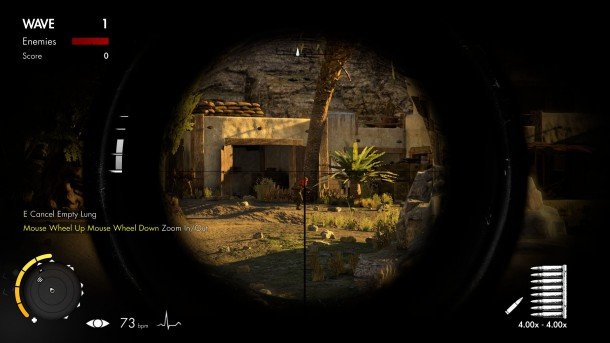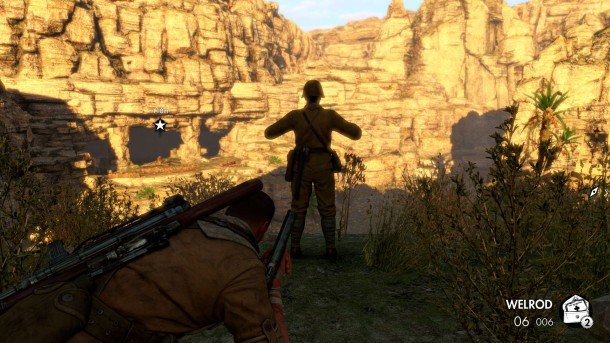Our Verdict
Fun sniping and great mission design just barely eclipse bugs, exploitable AI, and other issues that would make a lesser game impossible to recommend.
PC Gamer's got your back
“Save often,” says one of the tips in Sniper Elite 3's loading screen. I'm perplexed. The phrase used to be in every game, but among today's auto-saving checkpoints it feels anachronistic—impossible, even. You mean, I can save wherever I want? What is this, 2003?
Sniper Elite 3 is a third-person shooter with emphasis on stealth and long-range sniping, and it remembers the old days fondly—which is great. In the campaign, I expected to sneak between checkpoints in more or less a straight line, but I found big open maps and the freedom to solve problems how I wanted. In multiplayer, I expected to be asked to log in to something or other, but I found custom player-hosted matches and dedicated servers with 23 possible rules modifiers. Can we really have it so good in 2014?
Not quite. Where Sniper Elite 3 is a modern game, it's not modern in good ways. Most disappointing is that the $50 / £40 price tag is supplemented by a $30 / £25 Season Pass or $4-$9 / £3-£6 individual DLC packs which add guns and costumes. There are only four unlockable sniper rifles in the base game, and one more plus a couple sidearms isn't worth another $4 / £3. I also don't expect we'll hear plans for mod tools, which is a shame because there are only five multiplayer maps, and SE3 could have serious longevity with some community help.
Modern graphics aren't one of Sniper Elite 3's stand-out qualities, either. It certainly looks better than a game from 2003, but the character faces are plastic-like, and some of the cutscene animations are action-figure-stiff. The environments are detailed enough—often mazes of sun-drenched rock formations with crisp textures—but I caught a lot of flickering in the distance, which is especially disruptive when I'm trying to pick out bodies from the foliage.

The series' gruesome trademark, a slow-motion bullet cam that follows the projectiles through bones and organs with x-ray vision, is here and still misses the point. The gore is ridiculous enough to be funny, sometimes, but after the 50th brain-splosion I turned it off.
I'm not interested in how a bullet shatters a skull, or slices through lungs, or pops testicles. I don't love sniping for all the damage bullets do to human bodies. I love sniping because a great distance shot is a combination of reasoning and intuition that feels almost superhuman to pull off. I love the moments when I ask myself, “How the hell did I do that?”
In the regular difficulty levels, Sniper Elite robs you of that feeling. While looking through your scope, you can activate 'Focus Mode.' It's the 'hold your breath to steady your scope' function in most sniping games, but in Sniper Elite it also puts a red box where your bullet will go, taking into account gravity and wind speed if you have ballistics turned on.
There's no joy in clicking on the right part of the screen, doing none of the estimating and intuiting that makes a good shot a good shot. As in Sniper Elite V2, tactical assistance can be fully turned off in the custom difficulty settings. I highly recommend doing that, but I'm disappointed that SE3 expects me to rely on the magic ballistics calculator instead of training me in the fidelity of its world. There are lots of unlockable reticles, but no way to zero the scope, and no practice range with targets at set distances for me to calibrate my understanding of their markings. Red Orchestra 2 and Rising Storm are much better in that respect.
I learned through repetition, and it was worth it for all the shots I made that I never thought I could. I hit a commander, for instance, from at least 100 meters while he descended into the metal belly of his tank, his hat only barely visible beneath the lowering hatch. Later, I spotted a sniper far away on top of a tower. The way he was standing, all I could see was his elbow. Had I just pointed a red box at it and clicked, it wouldn't have meant anything. I guessed at a point half-an-inch below and just a few pixels to the right of my reticle's cross, and I shot his damn elbow myself.

As a shooting gallery, Sniper Elite 3 would be a pretty good one, but that's such a dull expression of sniping, which is about patience, positioning, and stealth as much as it is aim. SE3's campaign tries hard to ace those things, and defies the trend of linear, set piece-driven rides, which I commend it for. It's a huge improvement over Sniper Elite V2, that's for sure.
There are eight missions, and all but the first tutorial mission are big and open, with secrets and secondary objectives and multiple paths. I'm rarely forcefully pushed in one direction or told explicitly how to solve a problem.
In the first real mission, for instance, I sneak around German camps assassinating officers and searching their bodies for documents. I can shoot them from long-range entirely undetected, then sneak in and retrieve my prize, or I can sneak in first and slit their throats from behind. Or I can make a ton of noise and run around with my submachine gun hoping I don't die before I've shot everyone else. I can lay down booby-traps, throw rocks to distract guards—all your usual stealth stuff—but I'm never required to do one thing or another. It's a lot of fun to come up with a plan and execute it, and Sniper Elite 3 gives me the freedom and tools to do that.
The biggest problem is the enemy AI. On the lowest difficulty, the enemies are lobotomized—I saw one run face-first into a wall in pursuit of me. On the highest difficulty, the enemies are lobotomized and extremely aggressive. Neither are much fun to interact with, except to finish the job by putting another hole in their heads, and the system is easy to exploit.

Take one rifle shot, and enemies rush to cover. Stick around too long or take more shots, and they'll come for you. Run away for a bit, however, and they'll shrug off the corpse at their feet and go back to wandering around. Usually, I can just backtrack to a part of the level I already cleared out, then go right back to where I was.
One feature in particular does help keep hiding interesting: sound masking can let you take carefully-timed rifle shots without giving away your position. Having to track my target while I wait for audio cover—a backfiring generator, artillery fire—adds a great bit of tension to my technique.
When they happen, though, firefights are too often the result of technical issues rather than careless shooting. Firstly, there are no surround sound settings, and the audio system is a terrible judge of distance. I can hear enemy voices from way too far away, and it almost always sounds like they're right next to me. It's confusing.
Secondly, the third-person camera is cantankerous. It pivots either too fast or too slow depending on my mouse sensitivity, rolling around a point that feels like it's above my head, and the FOV is low and isn't adjustable (motion sick gamers take note). I've walked right by and alerted guards over and over because I couldn't see them or hear how close they were.

But the fun survives. The campaign is buggy and the AI behaves absurdly, but silently ambushing an AA gun crew with my suppressed Welrod pistol, nailing a distance shot, and then running around to keep the brainless Nazis from finding me can be very challenging and very rewarding. Playing carefully, I can spend two hours ghosting one mission, and enjoy all of it.
The competitive multiplayer stands out, too. There are only five maps and a few distinct modes, but what's there is good. I like 'No Cross' team deathmatch the best—it means that neither team can cross an invisible divider in the center of the map. No close-range combat, all sniping.
I appreciate that everything in the campaign is available in multiplayer, and can be turned on and off with modifiers. You can enable that red ballistics calculator if you want, though I prefer servers without it. You can disable running, turn on one-hit kills, or make it headshots only. Tagging is an especially interesting feature when its on. I never used it in the campaign because I insisted on turning off tactical assistance, but in mulitplayer, it's great.
When looking through binoculars (and only then), clicking on an enemy will alert your team to his location. Half the challenge of multiplayer is trying to find your enemy, and I love that I can play a whole round as a spotter, picking person pixels out from dirt pixels, tagging them, and watching one of my teammate's bullets streak across the map for the kill.

It's all very similar to Sniper Elite V2, but SE3 does everything a little better, and it does the campaign much better. I wish I could celebrate its classic stylings without any caveats, but I as much as I personally enjoy it, I can't look past the bugs, the exploitable AI, and the annoying movement system. The multiplayer is good, but there are too few maps and modes, and I'm not optimistic about mod support. I'm sure there will be plenty of DLC, though.
Some of Sniper Elite 3's failures are funny—a bugged-out Nazi flailing around the map, another gone catatonic—and some of them are frustrating, but its ideas are good and I hope they don't end here. If Rebellion can get its business model in check (and maybe earn some goodwill by not acting like an ass , a few big patches and a map editor could really bring that 2003 spirit back to life. Realistically, I expect we'll have to wait for Sniper Elite 4 for significant improvement.
Fun sniping and great mission design just barely eclipse bugs, exploitable AI, and other issues that would make a lesser game impossible to recommend.

Tyler grew up in Silicon Valley during the '80s and '90s, playing games like Zork and Arkanoid on early PCs. He was later captivated by Myst, SimCity, Civilization, Command & Conquer, all the shooters they call "boomer shooters" now, and PS1 classic Bushido Blade (that's right: he had Bleem!). Tyler joined PC Gamer in 2011, and today he's focused on the site's news coverage. His hobbies include amateur boxing and adding to his 1,200-plus hours in Rocket League.


